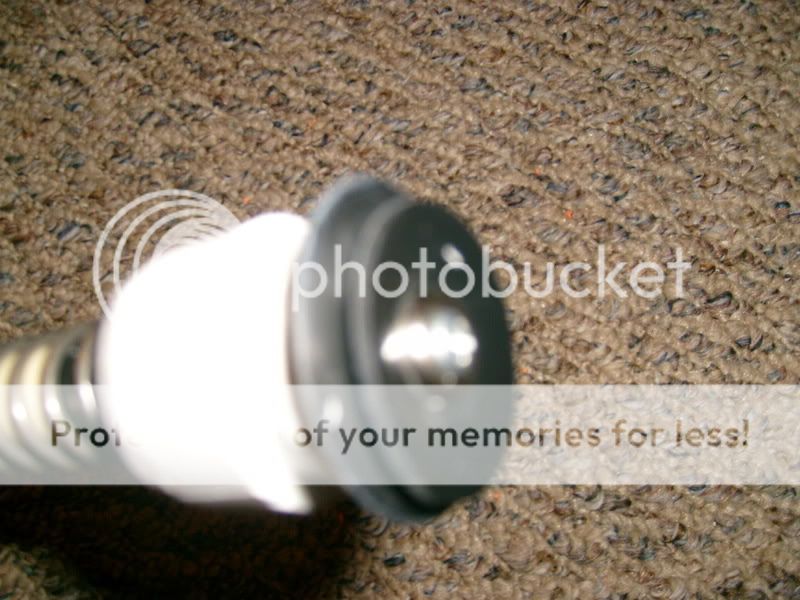Here’s what you’ll need (at minimum); some things can be substituted, but not all:
-PVC piping in 2”, 1 ¼”, ¾”, and ½” sizes.
-a pack of +bow springs (mcmaster part #9637k26)
-1/2” cpvc pipe
-1/2” cpvc T
-1/2” cpvc endcap
-3/4” coupler
-3/4” curved endcap
-3/4” plug
-3/4”x1/2” reducing bushing
-1/2”x3/4” slip/thread adapter
-1/2” T
-1/2” 45 deg. elbow
-(2) 1 ¼” couplers
-1 ¼” endcap
-1 ¼”x3/4” slip/thread bushing
-1/2” #6 pan head sheet metal screws
-3/4" #6 sheet metal screws (you just need one for the plunger head, so don't buy a huge pack).
-pack of 1/8”x1” cotter pins
-pack of small angle brackets
-pack of 3/16x1 1/2x1/16 rubber washers
-pack of 3/16x1 1/4x1/16 rubber washers
-pack of 3/16x1” fender washers
-pack of #8 finishing washers
-roofing nails
-industrial-strength clothespins
-small zip ties
-large zip ties
-hot glue sticks
-super glue
Tools: a hacksaw/pipe cutters, a drill, hot glue gun, 1/8”, ¼”, 5/8” drill bits, sanding drum/cutting blade.
Here’s what you’ll end up with:

Start with a 1 1/4’’ endcap, and drill a 5/8’’ hole in the exact center. Dremel the hole until the cpvc that you’ll be using as a plunger rod slides freely. Be sure that the hole is not so large that the spring (which fits perfectly around the ½” CPVC rod) can fit through; this would, in point of fact, be bad. Just go slowly and be careful. There should be a TINY gap all around the plunger rod, as you can see here. EDIT: If you don't want to be as careful about the size of the hole, and want even less friction, go ahead and grind it out a bit larger, and simply flare out the wire at one end of the spring. A tag of about 1/4" works perfectly.

To make the plunger, drill a 5/8” hole in the center of a ¾” endcap (curved). Make sure that the hole is a bit bigger than the plunger rod, so that the plunger head can shift around separately from the plunger rod. This keeps the plunger from binding. Jam a length of ½” CPVC through the hole, drill a 1/8” hole in the end, and put a cotter pin through the hole, wrapping it around the pipe. (reference Carbon’s SNAP-1 writeup; the process is identical). EDIT: wrap a bit of e-tape around the plunger rod, to keep the spring in place. If needed, you can also add a small screw at the end coil of the spring, to make sure it's not going to slip intp the plunger head. Cut a ¼” ring from the end of the endcap. Then, jam a ¾” plug into the endcap. Stack a #8 finishing washer, a 3/16” ID x 11/4” OD x 1/16” thick rubber washer, a 3/16” ID x 11/2” OD x 1/16” thick rubber washer, and a 3/16” ID x 1” OD fender washer on a 3/4" sheet metal screw, drill a 1/8” pilot hole in the center of the ¾” plug, and screw everything down; basically, it’s Carbon’s washer setup, with an extra washer for padding.

This way, the sealing washer is subject to far less wear, and the gun is significantly quieter. The handle is a ½” cpvc T, held on with a couple of screws (a cotter pin also works). The plunger shaft is a piece of cpvc 11 1/2" long.
Now, on to the pressure chamber. First, a 10 ¾’’ length of 11/4” pipe, and drill a 1/8’’ hole 3 7/8’’ from one end. Wiggle the drill bit, so that your trigger pin slides freely. Now, glue a coupler on, but don’t use cement. Instead, run a thin line of CA (super) glue around the ring at the center of the coupler.

Then shove your pressure chamber all the way down; the glue won’t take until it’s seated, so there will be less of a gap, and the blaster will be a bit more efficient. Wipe out any excess glue, and wait for the glue to dry. Drill four holes around the end of the coupler, seat a 1 ¼”x3/4” slip/thread coupler, and screw it down. Now you can use a screw-in adapter to use various barrel systems.
The trigger is a standard clothespin trigger in construction, but not materials. I use an industrial-strength clothespin, and a roofing nail as a catch. Hot glue the trigger onto the tube, reinforce with a zip-tie, and you’re done. Cover it up with a 1 ¼” trigger cover. This pic is from a much earlier prototype, but you get the idea.

For the grip, I just do as Carbon did on the SNAP-5 and the SNAP-6; drill two holes in a ½’’ cpvc endcap, screw it onto the 1 ¼” endcap, jam a ¾” boltsniper handle on the end, drill a couple of pilot holes in each side, screw it down, and reinforce with hot glue (to get rid of any annoying wiggling). Take special not of the screw placement; this is repeated on both sides.

Now, the stock. This needs to be both solid and comfortable. First, drill two pilot holes in each side of one side of a ¾” coupler, enlarge two of them to ¼” (access holes for your screwdriver), and screw the coupler onto the 1 ¼” endcap.

Reinforce the joint with a bit of hot glue (wherever I call for hot glue, you could also use epoxy, but I like to keep everything removable).

Now, build your stock out of ½” pvc; the pictured design is the one I find most comfortable, but use whatever works.

I use a ¾”x1/2” bushing to reduce it down; alternatively, you could just build the stock from ¾”, but ½” works fine, and is lighter and cheaper. I only recently made the jump to a ¾” coupler, but it works way better: it’s sturdier, and the extra bit of height keeps the plunger rod from barking your cheek. Screw it down, and you’re ready to go.
The screws that hold the stock and grip on also secure the 1 ¼” endcap to the pressure chamber. Be sure to drill a couple of vent holes somewhere behind the trigger; otherwise, a vacuum will be created when the plunger is released, slowing it significantly.
Finally, slap a fore-end on there. SNAPs tend to be skinny and bulbous—functional, but not too attractive (more importantly, such characteristics tend to be less than comfortable, especially with those screws sticking out all over the place). To start, cut a 1 ¼” coupler in half lengthwise, then cut the halves in half crosswise. The piece you want is on the left,next to a full coupler.

Take one of the pieces, and glue it on the pressure chamber, just ahead of the trigger guard. Now, cut 6” of 2” pvc, and split it down the middle, keeping your cuts as even as possible. Smooth the edges, and mount the resulting fore-end on the front coupler and the coupler piece, using a dab of hot glue on both.

The resulting blaster is extremely comfortable, solid in its construction, and very economical. I believe it to be a great alternative for those of us who want a blaster of this type, but don’t have access to a crossbow or plusbow (or who want something sturdy and cheap enough so that breakage is not really an issue). The SNAPbow is also quite powerful (somewhere between a crossbow and a plusbow), and very reliable in my experience. I believe it to be completely war-appropriate, as well. All feedback is appreciated. ~Rork
EDIT: gun porn time. There's one with a dogbone cpvc barrel, one with a 4-shot turret, and the first completed one, with a 6-shot turret and no foregrip.

ANOTHER EDIT: more detailed pics of how the business end of the plunger is made.



Of course, this piece just plugs right into the cut-down end cap. Happy building!
Edited by rork, 04 October 2008 - 05:35 PM.



















